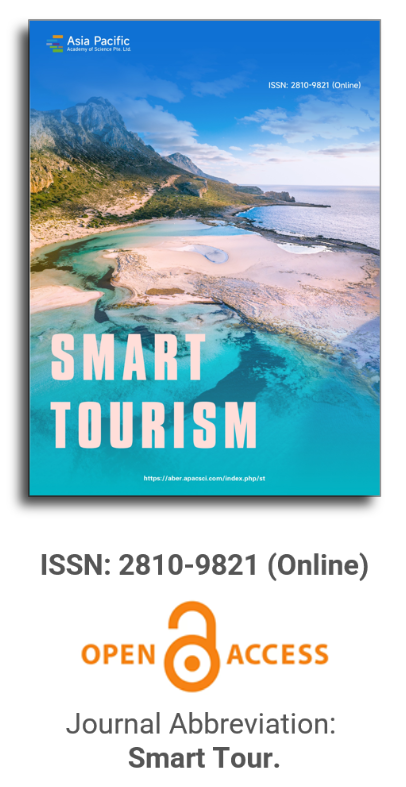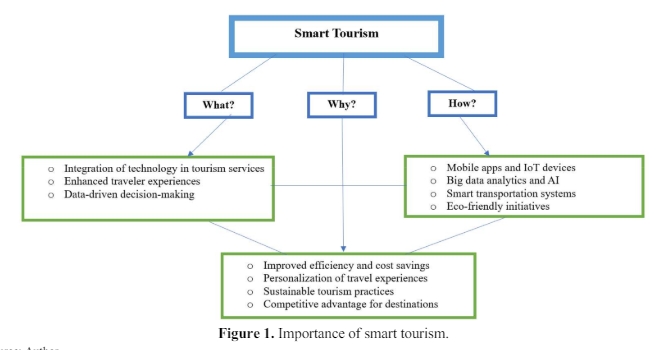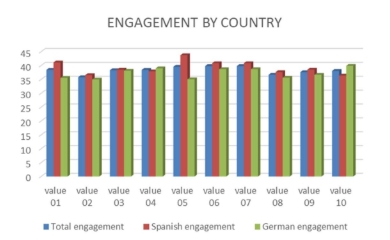


Triple helix stakeholder visions for smart tourism
Vol 3, Issue 1, 2022
Download PDF
Abstract
Objective: This research article seeks to analyze how academic progress in the field of tourism places value on the need to adopt technological advances in the framework of development for a sustainable future, taking this into account, this research studied the discourse of the actors involved in the triple helix in the face of smart tourism and its implementation in Colombia. Method: The methodological strategy contemplated a hermeneutic and inductive perspective, from the Grounded Theory that interpreted the discourses of the University, the Company and the State facing the phenomenon of interest, the information was codified in the Software. Findings: As a result, gaps and key factors that would allow, from the perspective of the groups approached, the success of smart tourism strategies were obtained. Conclusion: The technological appropriation of the Colombian tourism sector reveals a gap especially in the capacity to generate an intelligent offer in relation to the experience perceived by the consumer. Likewise, the discourse shows that, within the need for integration of the triple helix, building an intelligent service for the value proposition is one of the most important challenges for the sector and therefore a lag that must be jointly intervened at government, academic and business levels.
Keywords
References
- Ministry of Commerce, Industry and Tourism. El turismo obtuvo resultados históricos en 2018 (Spanish) [Tourism achieved historic results in 2018]. 2019.
- Ministry of Commerce, Industry and Tourism. Ocupación hotelera en 2018, lamás alta de los últimos 13 años (Spanish) [Hotel occupancy in 2018, the highest highest in the last 13 years]. 2019.
- Del Vecchio P, Passiante G. Is tourism a driver for smart specialization? Evidence from Apulia, an Italian region with a tourism vocation. Journal of Destination Marketing and Management 2017; 6(3): 163–165.
- Borseková K, Vaňová A, Vitálišová K. Smart Specialization for smart spatial development: Innovative strategies for building competitive advantages in tourism in Slovakia. Socio-Economic Planning Sciences 2017; 58: 39–50.
- Bugliarello G. Urban knowledge parks and economic and social development strategies. Journal of Urban Planning and Development 1996; 122: 33–45.
- Etzkowitz H, Leydesdorff L. The triple helix—university-industry-government relations: A laboratory for knowledge based economic development. EASST Review 1995; 14(1): 14–19.
- Sábato J, Botana N. La ciencia yla tecnología en el desarrollo futuro de América Latina (Spanish) [Science and technology in the future development of Latin America]. Revista de la Integración 1968; 1(3): 15–36.
- Tsaih RH, Hsu CC. Artificial intelligence in smart tourism: A conceptual framework. Proceedings of the International Conference on Electronic Business. Wuhan: ICEB; 2018. p. 124–133.
- Qurashi J, Sharpley R. The impact of SMART media technologies (SMT) on the spiritual experience of Hajj Pilgrims. International Journal of Religious Tourism and Pilgrimage 2018; 6(3): 37–48.
- Lim C, Mostafa N, Park J. Digital omotenashi: Toward a smart tourism design system. Sustainability (Switzerland) 2017; 9(12).
- Kim JY, Canina L. An analysis of smart tourism system satisfaction scores: The role of priced versus average quality. Computers in Human Behavior 2015; 50: 610–617.
- Castillo Hernández L, Lavín Verástegui J, Pedraza Melo NA. La gestiónde la triple hélice: fortaleciendo lasrelaciones entre la universidad, empresa, gobierno (Spanish) [The management of the triple helix: Strengthening the relationships between university, business, government, and the private sector] . Multiciencias 2014; 14(4): 438–446.
- Etzkowitz H, Leydesdorff L. The dynamics of innovation: From national systems and “mode 2” to a triple helix of university–industry–government relations. Research Policy 2000; 29(2): 109–123.
- Ramírez M del P, García M. La Alianza Universidad-Empresa-Estado: Una estrategia para promoverinnovación (Spanish) [The University-Business-State Alliance: A strategy for promoting innovation]. Revista EAN 2010; (68): 112–133.
- Ghaderi Z, Hatamifar P, Henderson JC. Destination selection by smart tourists: The case of Isfahan, Iran. Asia Pacific Journal of Tourism Research 2018; 23(4): 385–394.
- Hua Z. A study on the management model of smart tourism industry under the era of big data. The 2018 International Conference on Information Science and System; 2018 Apr 27; New York. New York, USA: ACM Press; 2018. p. 102–106.
- Koo C, Shin S, Kim K, et al. Smart tourism of the Korea: A case study. PACIS 2013 Proceedings; 2013.
- Alvarado-Uribe J, Gómez-Oliva A, Molina G, et al. Towards the development of a smart tourism application based on smart POI and recommendation algorithms: Ceutí as a study case. Advances in Intelligent Systems and Computing 2017.
- da Costa Liberato PM, Alén-González E, de Azevedo Liberato DFV. Digital technology in a smart tourist destination: The case of Porto. Journal of Urban Technology 2018; 25(1): 75–97.
- Kazak AN, Buchatskiy P. Perspectives for smart city technologies in the resort region. IEEE International Conference on Quality Management, Transport and Information Security, Information Technologies; 2018 Sep 24–28; St. Petersburg, Russia. Piscataway: IEEE; 2018. p. 845–847.
- Neuhofer B, Buhalis D, Ladkin A. Smart technologies for personalized experiences: A case study in the hospitality domain. Electronic Market 2015; 25(3): 243–254.
- Chhabra D. Strategic marketing in hospitality and tourism: Building a “SMART” online agenda. UK: Nova Science Pub Inc; 2015.
- Dorcic J, Komsic J, Markovic S. Mobile technologies and applications towards smart tourism—State of the art. Tourism Review 2019; 74(1): 82–103.
- Salvia M, Cornacchia C, Di Renzo GC, et al. Promoting smartness among local areas in a Southern Italian region: The smart Basilicata project. Indoor and Built Environment 2016; 25(7): 1024–1038.
- Nam K, Dutt CS, Chathoth P, et al. Blockchain technology for smart city and smart tourism: Latest trends and challenges. Asia Pacific Journal of Tourism Research 2019.
- Perles-Ribes JF, Ramón-Rodríguez A. Obliquity in tourism economics: Smart and sustainable tourist destinations. e-Review of Tourism Research 2019; 16(1): 45–55.
- Lee SJ. A review of audio guides in the era of smart tourism. Information Systems Frontiers 2017; 9(4): 705–715.
- Romão J, Kourtit K, Neuts B, et al. The smart city as a commonplace for tourists and residents: A structural analysis of the determinants of urban attractiveness. Cities 2018; 78: 67–75.
- Yoo C, Kwon S, Na H, et al. Factors affecting the adoption of gamified smart tourism applications: An integrative approach. Sustainability 2017; 9(2): 1–12.
- Guo W, Meng X, Zhang Y, et al. Spatial development model of sustainable tourism town based on smart city. Agro Food Industry Hi-Tech 2017; 28(1): 853–857.
- Buonincontri P, Marasco A. Enhancing cultural heritage experiences with smart technologies: An integrated experiential framework. European Journal of Tourism Research 2017; 17: 83–101.
- Rongrong Y. A mobile smart tourism and marketing system design for Harbin. Proceedings-2017 International Conference on Robots and Intelligent System; 2017; Huai’an, China. ICRIS; 2017. p. 12–14.
- Li Y, Hu C, Huang C, et al. The concept of smart tourism in the context of tourism information services. Tourism Management 2017; 58: 293–300.
- Della Corte V, D’Andrea C, Savastano I, et al. Smart cities and destination management: Impacts and opportunities for tourism competitiveness. European Journal of Tourism Research 2017; 17: 7–27.
- Kim JY, Hlee S, Joun Y. Green practices of the hotel industry: Analysis through the windows of smart tourism system. International Journal of Information Management 2016; 36(6): 1340–1349.
- Nitti M, Pilloni V, Giusto D, et al. IoT architecture for a sustainable tourism application in a smart city environment. Mobile Information Systems 2017.
- Gretzel U, Sigala M, Xiang Z, et al. Smart tourism: Foundations and developments. Electronic Markets 2015; 25(3): 179–188.
- Mandić A, Praničević DG. The impact of ICT on actors involved in smart tourism destination supply chain. e-Review of Tourism Research 2019; 16(2–3): 234–243.
- Hassannia R, Barenji AV, Li Z, et al. Web-based recommendation system for smart tourism: Multiagent technology. Sustainability (Switzerland) 2019; 11(2).
- Kuanrong Y, Guili C. Study on the construction of smart tourism supporting of system—Case study of Mount-Lu. 10th International Conference on Intelligent Computation Technology and Automation (ICICTA); 2017 Oct 9–10; Changsha, China. Piscataway: IEEE; 2017. p. 225–228.
- Smirnov A, Ponomarev A, Teslya N, et al. Human-computer cloud for smart cities: Tourist itinerary planning case study. Lecture Notes in Business Information Processing; 2017.
- Zhu Q, Wang Y, Zhang J, et al. Integrated navigation grid model and its applications in smart tourism routing. Journal of Southwest Jiaotong University 2017; 52(1): 195–201.
- Amorim M, Mar A, Monteiro F, et al. Smart tourism routes based on real time data and evolutionary algorithms. Euro-Mediterranean Conference; 2018 Oct 29. Berlin: Springer, Cham; 2018. p. 417–426.
- Almobaideen W, Allan M, Saadeh M. Smart archaeological tourism: Contention, convenience and accessibility in the context of cloud-centric IoT. Mediterranean Archaeology and Archaeometry 2016; 16(1): 227–236.
- Gautam BP, Asami H, Batajoo A, et al. Regional revival through IoT Enabled Smart Tourism Process Framework (STPF): A proposal. 2016 Joint 8th International Conference on Soft Computing and Intelligent Systems and 17th International Symposium on Advanced Intelligent Systems, SCIS-ISIS; 2016 Aug 25–28. Piscataway: IEEE; 2016. p. 743–748.
- Singh R, Anita G, Capoor S, et al. Internet of things enabled robot based smart room automation and localization system. Intelligent Systems Reference Library; 2019.
- Çeltek E. Smart technologies: Augmented reality applications in tourism marketing. In: Mobile computing and wireless networks: Concepts, methodologies, tools, and applications Vol. 2–4; 2015. p. 876–892.
- Tom Dieck MC, Jung T, Han D. Mapping requirements for the wearable smart glasses augment ed reality museum application. Journal of Hospitality and Tourism Technology 2016; 7(3): 230–253.
- Priano FH, Armas RL, Guerra CF. Developing smart regions: Proposal and application of a model forestland territories. International Journal of E-Planning Research 2018; 7(2): 89–114.
- Azzari M, Garau C, Nesi P, et al. Smart city governance strategies to better move towards a smart urbanism. Berlin: Springer, Cham; 2018.
- Liburd JJ, Nielsen TK, Heape C. Co-designing smart tourism. European Journal of Tourism Research 2017; 17: 28–42.
- Hernández-Martín R, Rodríguez-Rodríguez Y, Gahr D. Functional zoning for smart destination management. European Journal of Tourism Research 2017; 17: 43–58.
- Ruíz MAC, Bohorquez ST, Molano JIR. Colombian tourism: Proposal app to foster smart tourism in the country. Advanced Science Letters 2017; 23(11): 10533–10537.
- Dewey J. The Public and its problems. NYC: Holt Publishers; 1927.
- Dewey J. La experiencia y la naturaleza (Spanish) [Experience and nature]. México, Buenos Aires: Fondode Cultura Económica; 1948.
- De Gortari E. Lógica general (Spanish) [General logic]. Ciudad de México: La impresora azteca S. de R. L.; 1968.
- Strauss A, Corbin J. Basics of qualitative research: Techniques and procedures for developing grounded theory. California: Sage Publications; 2008.
- Kornbluh M. Combatting challenges to establishing trustworthiness in qualitative research. Qualitative Research in Psychology 2015; 12(4): 397–414.
- Schettini P, Cortazzo I. Análisis dedatos cualitativos en la investigaciónsocial (Spanish) [Qualitative data analysis in social research]. La Plata: Editorial de la Universidad de La Plata; 2015.
- Flick U. An introduction to qualitative research. 4th ed. London: Sage; 2009.
- Nick G, Pongrácz F, Radács E. Interpretation of disruptive innovation in the era of smart cities of the fourth industrial revolution. DETUROPE 2018; 10(1): 53–70.
Supporting Agencies
Copyright (c) 2022 Sandra Patricia Rojas-Berrio, Jeisson Leonardo Rincón-Novoa, Luz Alexandra Montoya-Restrepo
License URL: https://creativecommons.org/licenses/by/4.0/

This site is licensed under a Creative Commons Attribution 4.0 International License (CC BY 4.0).

Prof. Hung-Che Wu
Nanfang College, Guangzhou
China
Indexing & Archiving
Asia Pacific Academy of Science Pte. Ltd. (APACSCI) specializes in international journal publishing. APACSCI adopts the open access publishing model and provides an important communication bridge for academic groups whose interest fields include engineering, technology, medicine, computer, mathematics, agriculture and forestry, and environment.



.jpg)
.jpg)

.jpg)

